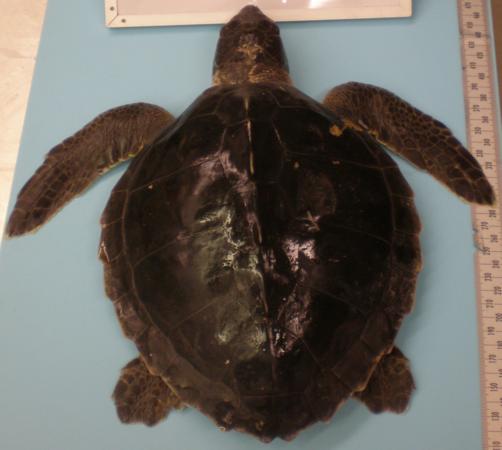Marine Mammals

Species of marine mammals that have stranded in Maryland since 1900:
| Toothed Whales (Odontocetes) | Baleen Whales (Mysticetes) |
|---|
| Atlantic white-sided dolphin | Fin Whale |
 Bottlenose dolphin Bottlenose dolphin |
 Humpback Whale Humpback Whale |
| Common Dolphin | Minke Whale |
| Dwarf Sperm Whale | North Atlantic Right Whale |
| Gervais' Beaked Whale | Seiwhale |
| Long-Finned Pilot Whale | Seals (Pinniped) |
|---|
| Pigmy Sperm Whale |
 Harbor Seal Harbor Seal |
| Risso's Dolphin | Harp Seal |
| Short-Finned Pilot Whale | Hooded Seal |
| Sperm Whale | Gray Seal |
| Striped Dolphin |
| True’s Beaked Whale |
| Spotted Dolphin |
| Clymene Dolphin |
Manatee
|
|---|
The most commonly stranded toothed whale, or odontocete, in Maryland is the bottlenose dolphin (Tursiops truncatus). The most commonly stranded baleen whale, or mysticete, is the humpback whale. The most commonly stranded seal, or pinniped, is the harp seal. Marine mammals strand for a variety of reasons including old age, disease, major trauma (vessel strike), predation, entanglement in fishing gear, and parasitism. On average, 15 marine mammals strand each year. Most strandings occur on the Atlantic Ocean coast.
Marine mammals tend to strand seasonally based on the species and its range. For example, the harbor porpoise tends to strand in the late winter or early spring, while the bottlenose dolphin tends to strand in late spring, summer, and early fall. Seals tend to be in Maryland during the winter.
Marine Mammals are protected by law under the Marine Mammal Protection Act which prohibits the "taking" of marine mammals in all US waters. A "take" is defined as "to harass, hunt, capture, kill, or feed any marine mammal". Marine mammals are still protected under these laws even after their death. Collecting dead marine mammal remains is also considered a "take". Violations of the Marine Mammal Protection Act can result in hefty fines, imprisonment, or the seizure of vessels and personal property.
Here are some things you can do to help marine mammals:
-
KEEP your distance from dolphins and other marine mammals. Put your engine in neutral while the animal(s) pass. Never follow or chase a dolphin, whale, or other marine mammal.
-
NEVER cast your fishing line where you have seen dolphins and marine mammals surfacing to breathe. Dolphins are naturally curious and may stay near you-especially if you are near fish-their favorite food.
-
NEVER feed dolphins or other marine mammals, this is just as dangerous for the person as the dolphin.
-
KEEP all of your garbage picked up! Garbage in the water is confused as food and can be fatal if eaten by dolphins, whales, and other marine mammals.
-
KEEP your distance from seals! Seals can be aggressive, especially toward pets (ie- your dog on its leash). Seal bites can be both painful and unsafe, since they can transmit diseases to humans and our domestic pets.
Sea Turtles
Species of sea turtles that have stranded in Maryland since 1991:

The most commonly stranded sea turtle in Maryland is the loggerhead sea turtle (Caretta caretta). The largest sea turtle in the world is the leather back, which can weigh up to 1 ton (2,200 pounds). On average Maryland has 25 dead sea turtles strandings each year. Most strandings occur along the Atlantic Coast, however, sea turtles have stranded as far north as the Magothy River in the Chesapeake Bay.
Each year, when water temperatures warm, sea turtles visit the Chesapeake Bay and water's off Maryland's coast. Sea turtles eat a variety of prey found within our waters including jellyfish, horseshoe crabs, crabs, and whelks. Individuals often return to the same feeding grounds each year and in between nesting periods.
Sea turtles strand due to a variety of natural and human causes. Natural causes of stranding or death can be due to old age, disease, predation, and cold stunning (hypothermia). Human induced strandings can be caused by hunting, boat strikes, fishing gear entanglement, and habitat degradation.
Sea turtles are protected under the Endangered Species Act (1973) and Maryland Non-Game and Endangered Species Conservation Act (1975). Sea turtles are still protected under these laws even after their death. Collecting dead sea turtles remains is also considered a violation. Violations of these laws can result in hefty fines, imprisonment, or the seizure of vessels and personal property.
What you can do to help sea turtles:
-
NEVER cast your fishing line where you have seen sea turtles surfacing to breathe. Sea turtles may be attracted by your bait and can get hooked on your line which would damage your rod, and hurt the turtle.
-
ALWAYS clean up your trash! Sea turtles can confuse garbage, especially plastic, floating in water for food. If sea turtles eat garbage they can die.
-
RECYCLE your monofilament line! Even small pieces can entangle a sea turtle or be confused for food.
-
REDUCE your speed in areas where sea turtles are seen. Sea turtles are susceptible to boat strikes which are fatal in most cases.
To report a live, entangled, or dead sea turtle please call: 1-800-628-9944 (24/7, toll free in Maryland). Entangled turtles, turtles with deep cuts or embedded hooks need veterinary care. Call Stranding Responders immediately at 410-373-0083 or 443-758-6607 or US Coast Guard on CH-16 on your VHF radio.
